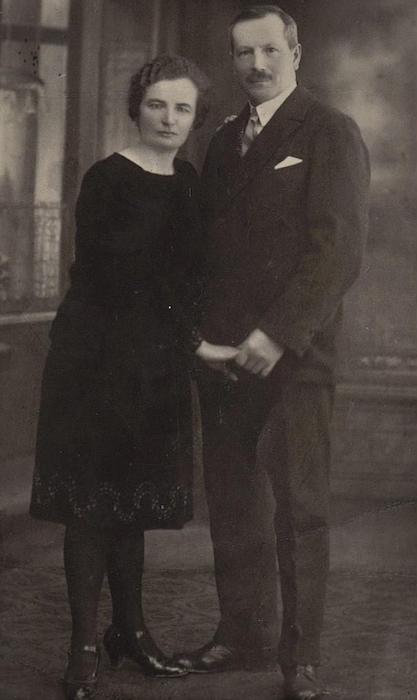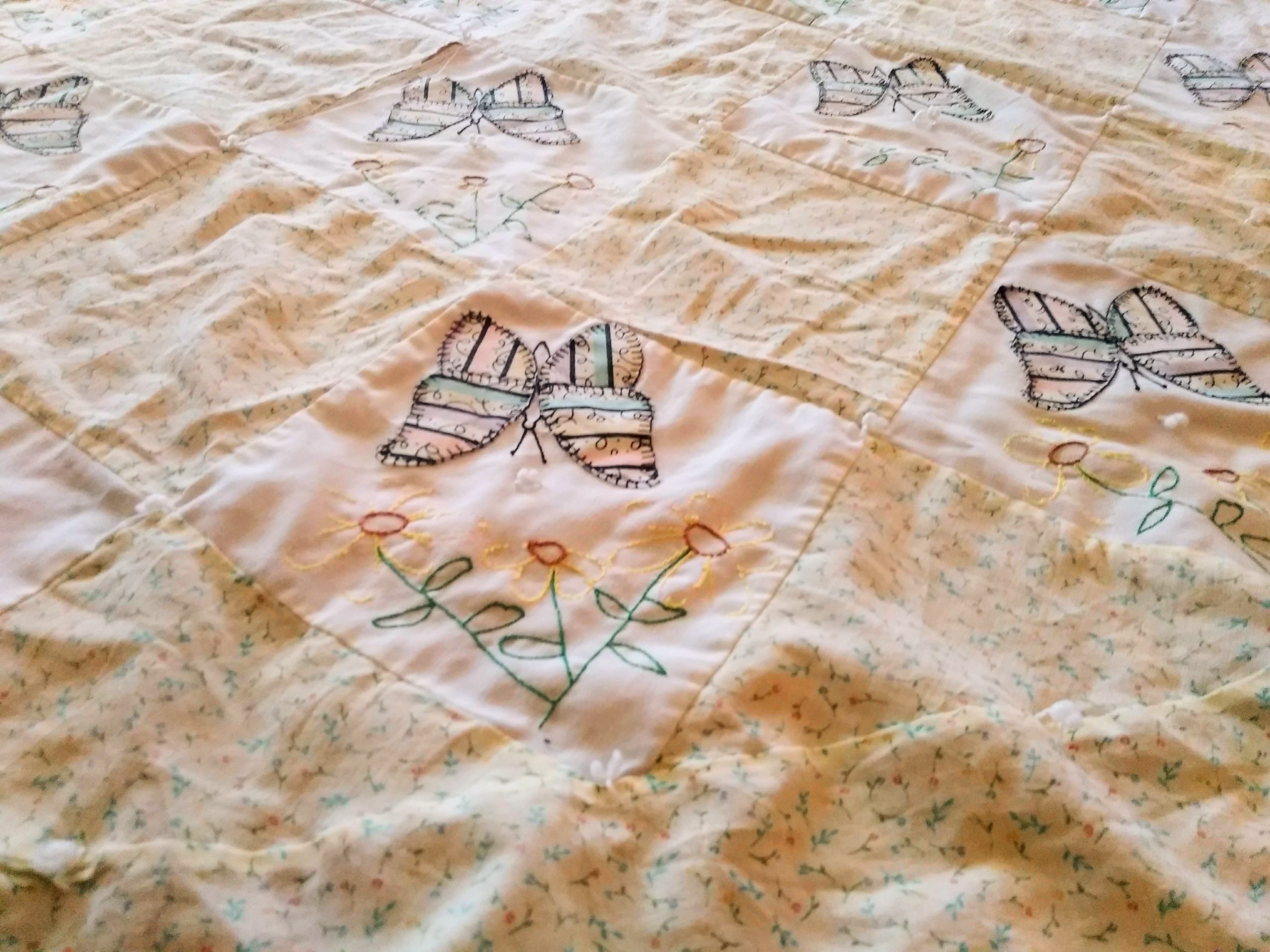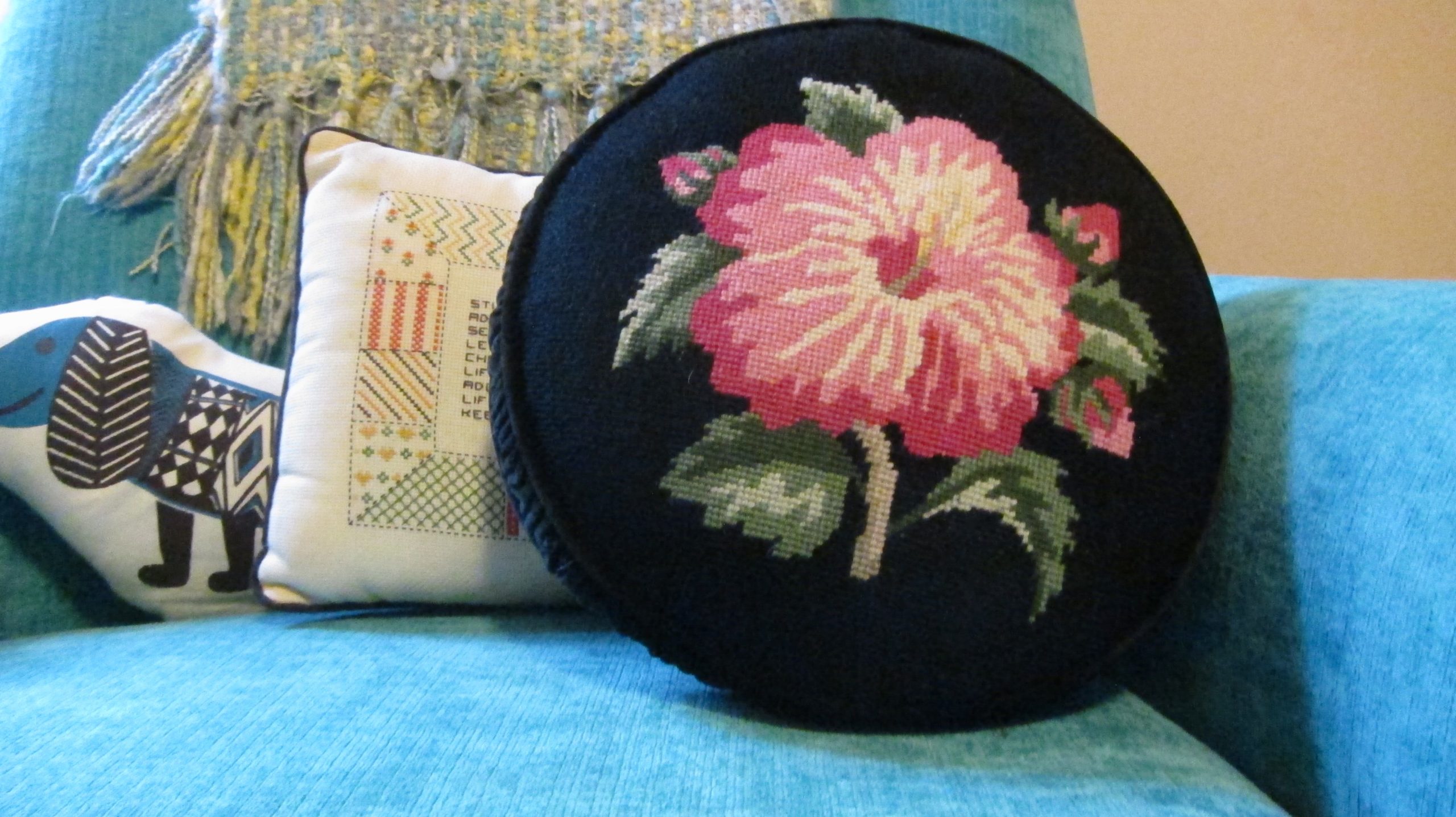Dear Textiles,
If you traveled back to 2015 and, after the prerequisite warnings about the last 4 years, told me that in 5 years my full-time job would be running an international fiber-art-activism project that I started with the woman I had just met that summer… well in hindsight it might not have been the wildest part of the conversation, but it certainly would’ve been shocking.
Back then I’d have told you that I’m not a crafter. Sure, I’d done the occasional crafty thing – everyone remembers making those beaded geckos in the ’90s, right? – but they never developed into a hobby. To be honest, I’m not even sure how I’d describe myself now. Am I a crafter? An artist? An activist? Data analyst? Researcher? Science communicator? Who knows? I’m just a person who cares deeply about climate change and loves spreadsheets more than most. So… how did all this get started?
(Click all photos to see them in a larger version)
(Left to right: The Tempestry Project founders: Emily, Asy, and Marissa.)
I guess I should start at the beginning – meeting my partner, Emily. We met in the summer of 2015, a few months after she’d moved from New York City to my small town on the west coast, and our friendship quickly became a partnership. She always had something soft on her needles, from scarves to cowls to lovely lace shawls. Knitting had been her passion and pastime for a decade by then. As for me, I’m a tinkerer. I’d had many jobs, most of them revolving around drafting and 3D modeling, and have something of an engineer’s brain. That fall I was tinkering with a DIY 3D printer kit from a Kickstarter I’d supported, and had done a few prints of simple little things. Then one evening Emily got frustrated.
She often used rubber bands to keep her knitting and needles together after having those annoying rubber point protectors pop off one too many times in her project bags while walking to and from work at our local yarn shop. On this fateful evening, it was a fine lace shawl on the needles, and the yarn got bound up in the rubber band and the process of untangling the mess broke the delicate yarn. My brain went into problem solving mode and after asking a few questions about common needle sizes, I told her I’d do some tinkering and get back to her.
A week later I presented her with the very first Needle Wrangler, hot off the 3D printer – a simple little gadget to keep needles together and stitches firmly in place, without frustrating tangles. She was delighted so I printed several more for her various projects (or WIPs, as I came to learn). Over the next few months local knitters were noticing the Needle Wranglers on her projects at the shop and it turned out there was a market for them. Soon I had the printer running nearly 24/7 just to keep up with our LYS’s demand.
We’ve since been granted a patent and trademark for Needle Wranglers and graduated from 3D printing to having them injection molded for us by a small company in a nearby town, and they’ve been picked up by Bryson Distributing and are available in local yarn shops around the country! Whew!
And all of that is really just tangential to our primary focus – the Tempestry Project.
Around inauguration in 2017 we were reading all these articles about hackers and scientists working together to download and save scientific data (particularly climate data) from government sources for fear of the incoming administration deleting it or removing access to it. We joked about how ephemeral modern data storage is, how massive amounts of data can disappear at the press of a button, and how we should be recording important data sets using ancient techniques like cuneiform tablets or tapestries that last centuries or millennia. Given Emily’s background in knitting and her involvement in the local knitting community by way of the yarn shop, we realized that maybe we were on to something with the tapestry idea.
Knitting temperature wasn’t a novel idea. Knitters and crocheters have been making temperature blankets for ages, but these were always individual efforts and often focused on the current year as a very personal mindfulness exercise.
Knitting temperature wasn’t a novel idea. Knitters and crocheters have been making temperature blankets for ages, but these were always individual efforts and often focused on the current year as a very personal mindfulness exercise. We wanted to create a framework through which people could create temperature tapestries (Tempestries) that would be comparable from place to place and, crucially, from time to time. We wanted people to use historical temperature data to make Tempestries that could show the effects of climate change, an issue I’ve been obsessing over for decades. We spent several months working out the details. It would have been great to use yarn from our LYS but all of their yarn is hand dyed and we needed colors to be consistent. We also wanted to keep costs down because we didn’t want that to be a barrier to entry for anyone wanting to participate. We worked out a spectrum of 32 colors representing temperatures ranging from less than -31°F to greater than 121°F in 5°F increments. We settled on the linen stitch as our suggested stitch because it makes a beautiful, sturdy fabric that hangs nicely without stretching or curling.
Once we’d worked out all these details we put it all up online for free. This included my spreadsheet for processing NOAA weather data into a knitable worksheet, the knitting pattern (more like suggested guidelines), a guide for how to download data directly from NOAA, a printable color card template – everything we could think of that someone might need in order to make a Tempestry. We started showing our work to the local knitting community as soon as Emily finished the first one in May 2017. They were very excited about what we were doing, but many of them just wanted to knit a Tempestry without doing all the behind-the-scenes work of data research and spreadsheets. At their request, we started making kits that would have everything they needed. People would request a year and location, I would track down the data and process it into a worksheet, and Emily and our roommate, Marissa, would hand-wind all the yarn colors into exactly the right amounts needed for each temperature range. And that’s how our business accidentally got going.
And that’s how our business accidentally got going.
After making the first Tempestry (for Deception Pass, WA, 2016) Emily and Marissa got busy making four more that were displayed that June as the first showing of what would become our Deception Pass Collection. This collection now includes over twenty Tempestries depicting temperatures from years ranging from 1948 through 2016, knitted by over a dozen volunteers.
Since that first local exhibit in 2017, I quit my day job to do this full time (“this” mostly consists of finding and preparing custom temperature data for people). We’ve made thousands of Tempestry kits including for all 50 states, over 30 countries, and for all 7 continents. We’ve carried our Tempestries like medieval war banners to climate protests and marches. Tempestry collections (in progress or finished) have been created for places ranging from Australia to the San Juan Islands and Philadelphia to Mexico City, with more and more cropping up every year. There’s even a National Parks Tempestry Collection (click the link to view an image gallery) with about a hundred participants organized by an avid knitter, environmentalist, and writer for the National Parks Traveler Magazine. We were invited to enter our work in the 2018 Creative Climate Awards in New York; a Tempestry workshop was hosted by the Philadelphia Museum of Art, and we’ve been featured in various publications from Smithsonian Magazine to the New York Times. Our New Normal Tempestries, based on Professor Ed Hawkins’ Warming Stripes data visualization showing global and regional warming trends over the last century, have been displayed in classrooms, public libraries, universities, and even government offices — made by knitters and crocheters around the country.
It has been an incredible, at times grueling and stressful, wild ride up to this point, and this summer we’ve taken on two more new and exciting endeavors.
It has been an incredible, at times grueling and stressful, wild ride up to this point, and this summer we’ve taken on two more new and exciting endeavors.
In June, we started a project with my daughter where she keeps track of her daily mood and we knit a row every day representing the color that best fits the day — red for anger, blue for sadness, yellow for happy, etc. It’s been a simple and comforting way to think and talk about emotions during these staggering times we’re living through. The Tempestry community liked this idea so much that we’ve started offering Emotion Tempestry kits, with the hope that others will benefit from the practice as much as we have.
And our biggest project to date is also in the works: creating an entire line of custom milled and dyed worsted weight Tempestry yarns in all 38 of our colors. We’re excited to be working with a a Pennsylvania-based fiber mill and a Pennsylvania-based dyeworks, and delighted that our kits will soon be using US-sourced merino wool — and supporting American jobs.
I feel incredibly fortunate that my life has taken this drastic turn for the worsted, and grateful that the textile community has welcomed me into the fold. I got to fly in a plane for the first time when we went to the Creative Climate Awards in New York, we’ve been interviewed on a couple podcasts, and I even did a pair of brief interviews on the Weather Channel.
Five years ago I would never have imagined the life I’m leading, and while I’ve only knit one and a half hats so far, my whole life now revolves around textiles — and I can’t wait to see what’s next.
– Asy Connelly
Our website: tempestryproject.com.
We also have a Tempestry Project Instagram,FaceBook page and a Facebook group for Tempestry Project Participants (or those interested).

















